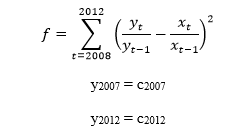ASM Benchmark Methodology
ASM Benchmark Methodology
Benchmarking adjusts the level of a given series to the levels (referred to as benchmarks) from a less frequent survey that is assumed to be of better quality, while attempting to minimize revisions to the period-to-period changes for the original series. The benchmarking procedure helps to produce consistent time series and reduces the effects of sampling and non-sampling errors in the original series. For annual series in the Economic Directorate, such as the Annual Survey of Manufactures (ASM), it is good statistical practice to benchmark the series to the Economic Census.
The published level estimates from the ASM play an important role in benchmarking the level estimates from the Manufacturers’ Shipments, Inventories, and Orders (M3) Survey. Also, the Bureau of Economic Analysis and the Federal Reserve Board utilize both the published levels and the year-to-year changes in producing modeled estimates. Because it is important that the estimates from the ASM be of the highest possible quality, published level estimates from the ASM have been benchmarked to published level estimates from the Census of Manufactures.
ASM estimates benchmark to Economic Censuses by setting the ASM annual estimates equal to the census benchmarks in census years. The procedure then minimizes revisions to the original ASM estimates for years between the census benchmark years. The benchmarking methodology is as follows.
Let xt > 0 denote the originally published annual estimate for year t, yt > 0 denote the revised benchmarked annual estimate for year t, and ct > 0 denote the census benchmark for year t. The trend revision benchmarking methodology is an iterative procedure that attempts to minimize revisions to the year-to-year change while adjusting the annual levels, by finding a local minimum for the following function f and two constraints.

Using level estimates from the 2017 and 2022 Censuses of Manufactures as benchmarks, 2018-2021 ASM benchmark estimates were calculated for sixteen general statistics data items. For each of the general statistics items, the benchmark estimates were computed at the 6-digit NAICS level and then aggregated to the higher publication levels. Detail items (ex: inventory stages of fabrication), that are part of a published total item (ex: total inventories), were first benchmarked and then raked to the benchmarked total item. Value added was benchmarked indirectly by using its benchmarked component items. For the 2012 benchmarking, value of product shipments were benchmarked at the 7-digit ASM product class level. For 2017 and 2022 benchmarking, due to NAPCS codes replacing product lines, there was no benchmarking done for NAPCS codes.
Disclosure avoidance
Disclosure is the release of data that reveals information or permits deduction of information about a particular survey unit through the release of either tables or microdata. Disclosure avoidance is the process used to protect each survey unit’s identity and data from disclosure. Using disclosure avoidance procedures, the Census Bureau modifies or removes the characteristics that put information at risk of disclosure. Although it may appear that a table shows information about a specific survey unit, the Census Bureau has taken steps to disguise or suppress a unit’s data that may be “at risk” of disclosure while making sure the results are still useful.
Cell suppression is a disclosure avoidance technique that protects the confidentiality of individual survey units by withholding cell values from release and replacing the cell value with a symbol, usually a “D”. If the suppressed cell value were known, it would allow one to estimate an individual survey unit’s response too closely.
The cells that must be protected are called primary suppressions.
To make sure the cell values of the primary suppressions cannot be closely estimated by using other published cell values, additional cells may also be suppressed. These additional suppressed cells are called complementary suppressions.
The process of suppression does not usually change the higher-level totals. Values for cells that are not suppressed remain unchanged. Before the Census Bureau releases data, computer programs and analysts ensure primary and complementary suppressions have been correctly applied.
In accordance with federal law governing census reports (Title 13 of the United States Code), no data are published that would disclose the operations of an individual establishment or company. Additional information on the techniques employed to limit disclosure in the Census Bureau’s economic surveys are discussed at: https://www.census.gov/programs-surveys/economic-census/technical-documentation/methodology/disclosure.html
Disclosure analysis is performed at the field level, i.e., disclosure analysis performed for each variable independent of other variables for that NAICS-based industry or product class. When data for a NAICS-based industry or product class are suppressed, these data still are included in higher-level totals.
The Census Bureau has reviewed the data products to ensure appropriate access, use, disclosure of confidential avoidance protection of the confidential source data used to produce this product (Data Management System (DMS) number: P-7500114, Disclosure Review Board (DRB) approval number: CBDRB-FY25-0197, approved March 17, 2025.)



